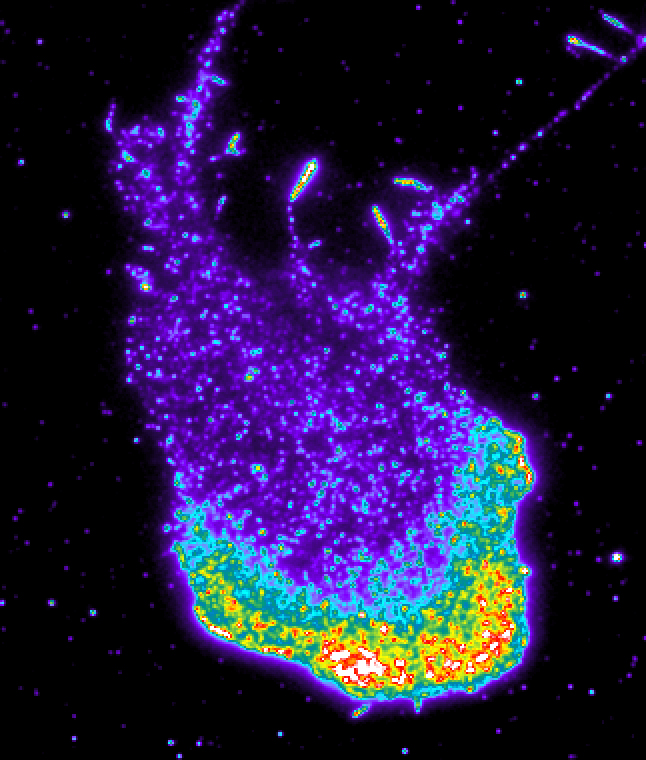The Solution to a 50-Year-Old Riddle: why Certain Cells Repel one Another

A motile fibroblast: the protein srGAP2, which initiates the repulsion reaction, is heavily concentrated at the front of the cell (below, in red, yellow, and green). © University of Basel, Prof. Pertz group
Fibroblasts are motile constituents of the connective tissue and also regulate its stiffness. Moreover, fibroblasts play an important role in malignant skin diseases such as melanoma. In research, they serve as a model system for studying cell migration.
Signaling pathway identified
In the early 1950s, the English researcher Michael Abercrombie discovered that colliding fibroblasts repel one another and, in the process, change their direction of motion. He called this phenomenon ‘contact inhibition of locomotion’. Although individual proteins were identified as key factors in this process, the molecular basis of this reaction remained something of a puzzle.
In particular, it was unclear which repulsion signals were involved in the process, how these signals entered the cells from the outside, and how they influenced the cytoskeleton, which in turn regulates the cell’s movement.
Prof. Olivier Pertz’s research group at the University of Basel has now precisely answered these questions. The group identified a coherent signaling axis consisting of three proteins called Slit2, Robo4, and srGAP2 which operates as follows:
– The repulsion factor Slit2 binds to the receptor Robo4, whereupon the signal enters the cell’s interior and activates srGAP2.
– This molecule consequently inhibits the regulator Rac1, which coordinates the cytoskeleton.
– The inactivation of Rac1 causes the cell to retract – such that the two cells repel one another.
If the function of Slit2, Robo4, or srGAP2 is deactivated, colliding cells will stick to one another and will not separate as easily.
A ‘molecular bumper’
Intriguingly, the repulsion machinery is localized at the front – even in freely moving cells. By assembling this kind of a ‘molecular bumper’, the cell is prepared for collision with another cell. Where exactly this bumper must be positioned – namely, only in parts of the cell that are moving forwards – is determined by the cell’s geometry, which in turn is deciphered by srGAP2.
The integration of membrane curvature and repulsion signals ensures that cell-cell repulsion takes place at the correct location. This repulsive reaction could play an important role in cancer metastasis. This is supported by the fact that the expression of Slit and Robo isoforms is deregulated in several tumor types.
Original source
Rafael Dominik Fritz, Denis Menshykau, Katrin Martin, Andreas Reimann, Valeria Pontelli, and Olivier Pertz
SrGAP2-Dependent Integration of Membrane Geometry and Slit-Robo-Repulsive Cues Regulates Fibroblast Contact Inhibition of Locomotion
Developmental Cell (2015), doi: 10.1016/j.devcel.2015.09.002
Further information
Prof. Dr. Olivier Pertz, University of Basel, Department Biomedicine, tel. +41 61 267 35 41, email: olivier.pertz@unibas.ch
Media Contact
More Information:
http://www.unibas.chAll latest news from the category: Life Sciences and Chemistry
Articles and reports from the Life Sciences and chemistry area deal with applied and basic research into modern biology, chemistry and human medicine.
Valuable information can be found on a range of life sciences fields including bacteriology, biochemistry, bionics, bioinformatics, biophysics, biotechnology, genetics, geobotany, human biology, marine biology, microbiology, molecular biology, cellular biology, zoology, bioinorganic chemistry, microchemistry and environmental chemistry.
Newest articles

Innovative vortex beam technology
…unleashes ultra-secure, high-capacity data transmission. Scientists have developed a breakthrough optical technology that could dramatically enhance the capacity and security of data transmission (Fig. 1). By utilizing a new type…

Tiny dancers: Scientists synchronise bacterial motion
Researchers at TU Delft have discovered that E. coli bacteria can synchronise their movements, creating order in seemingly random biological systems. By trapping individual bacteria in micro-engineered circular cavities and…

Primary investigation on ram-rotor detonation engine
Detonation is a supersonic combustion wave, characterized by a shock wave driven by the energy release from closely coupled chemical reactions. It is a typical form of pressure gain combustion,…



